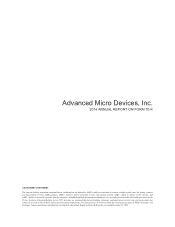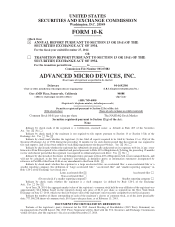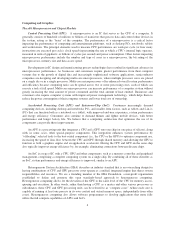AMD 2014 Annual Report Download - page 14
Download and view the complete annual report
Please find page 14 of the 2014 AMD annual report below. You can navigate through the pages in the report by either clicking on the pages listed below, or by using the keyword search tool below to find specific information within the annual report.mobility, relatively low power, small form factor, and 24x7 operations. High performance graphics are
increasingly important in many embedded systems. Support for Linux, Windows and other operating systems as
well as for increasingly sophisticated applications are also critical for some customers. Other requirements may
include meeting rigid specifications for industrial temperatures, shock, vibration and reliability. The embedded
market has moved from developing proprietary, custom designs to leveraging industry-standard instruction set
architectures and processors as a way to help reduce costs and speed time to market.
Semi-Custom.We have leveraged our core IP, including our graphics and processing technologies
developed for the PC market, to develop semi-custom solutions for customers who want differentiation in their
products, including today’s leading game console manufacturers. In this market, semiconductor suppliers work
alongside game console manufacturers to enhance the visual performance and overall user experience for game
console customers. This same type of collaborative development approach can also address customer needs in
many other markets beyond game consoles, leveraging our existing IP to create a variety of products tailored to a
specific customer’s needs, ranging from complex fully-customized SoCs to more modest adaptations and
integrations of existing CPU, APU or GPU products.
Our Enterprise, Embedded and Semi-Custom Products
Server Processors. Our microprocessors for server platforms currently include:
• The AMD OpteronTM X-Series includes small-core x86 APUs and CPUs that are ideal for
next-generation scale-out Web and cloud applications ranging from big data analytics to image
processing, multimedia content delivery and hosting.
• AMD Opteron 6300 Series processors, which are designed to meet the demanding performance per-
watt, per-dollar requirements that are at the heart of server buying decisions. The AMD Opteron 6338P
(12 core) and 6370P (16 core) processors are optimized to handle the heavily virtualized workloads
found in enterprise environments. These processors feature the “Piledriver” core and are fully socket
and software compatible with the existing AMD Opteron 6300 Series.
During 2014, we began sampling the AMD Opteron A1100 Series processor, our first 64-bit ARM-based
server processor based on 28nm technology. AMD Opteron A-Series processors combine AMD’s expertise in
delivering server-class silicon with ARM’s trademark low-power architecture. These products are designed to
bring the experience and technology portfolio of an established server processor vendor to the ARM ecosystem
and complement our AMD Opteron x86 server processors. The first AMD Opteron A-Series processors are
expected to launch later in 2015.
Dense Server Systems. In addition, to offering microprocessors for servers, we offer dense server systems,
designed to reduce power consumption and improve space efficiency for data centers. Our dense server products
currently include the SeaMicro SM15000™ server, as well as the SeaMicro Freedom™ Fabric Storage series of
storage enclosures. SeaMicro dense servers incorporate our proprietary fabric technology, the Freedom™
supercomputer fabric, which interconnects hundreds of card-sized motherboards, eliminating top-of-rack
switches, terminal servers, hundreds of cables and thousands of unnecessary components for a more efficient and
simple operational environment. We designed this fabric to reduce data center power consumption while
providing low latency and higher bandwidth interconnections.
Embedded Processors. Our embedded processors are increasingly driving intelligence into new areas of
our lives, from smart TVs and set-top boxes to interactive digital signage, casino gaming, and medical imaging.
These products are designed to support greater connectivity and productivity, and we believe they are a strong
driver for the “internet of things” and “surround computing” areas in the computing industry. Our processor
products for embedded platforms include the following:
• Our second generation AMD Embedded R-Series APU and CPU launched in May 2014, formerly
codenamed “Bald Eagle,” supports HSA and was designed for processing performance, power
8
























